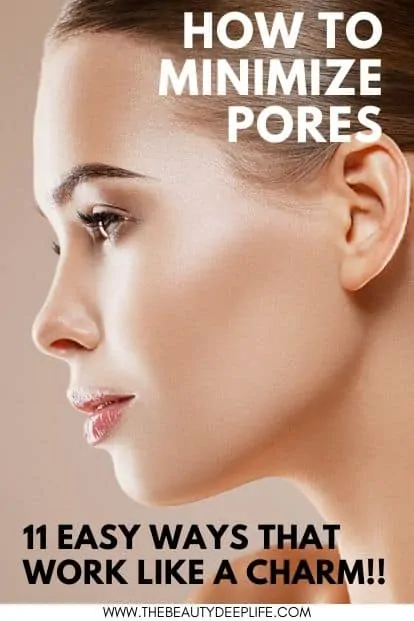
Achieve Flawless Skin Perfection & Reduce The Appearance Of Large Pores On Your Face!!
Have you ever looked in the mirror only to feel bummed and a little frustrated? Found yourself wondering, realistically what was it going to take to minimize the pores on your face for good? Or maybe you’ve started to worry as they seem to be growing in size with each year that goes by?
Well, rest assured, you are not alone. Ladies, generally, in our mid to late twenties, and for some in our early thirties, we begin to notice a change in our skin…that rather unfortunate increase in the size of our pores.
And certainly, if you are in your mid 30’s and up, I’m sure you know exactly what I mean. I remember the day I started to notice the change, staring in the mirror and thinking, “Where did these big, gaping holes come from!!??”
I realized the same ole’ same ole’ was not going to cut it as far as my skin was concerned. Something needed to change quickly, and I definitely didn’t want things to get any worse! It was time to implement a few switch-ups!
Just keep in mind, ladies, we are our own worst critics, and the average person is not walking around with a magnifying mirror looking at the pores on your face. But having some tangible solutions can help, and I know from experience that it can certainly make you feel better to have options.
Therefore, I’d love to share some tricks, tips, and product advice with you Beauties today! In fact, if you are a makeup lover, you’ll LOVE Tip #9’s suggestions for creating a flawless look, hiding those pores & imperfections!!
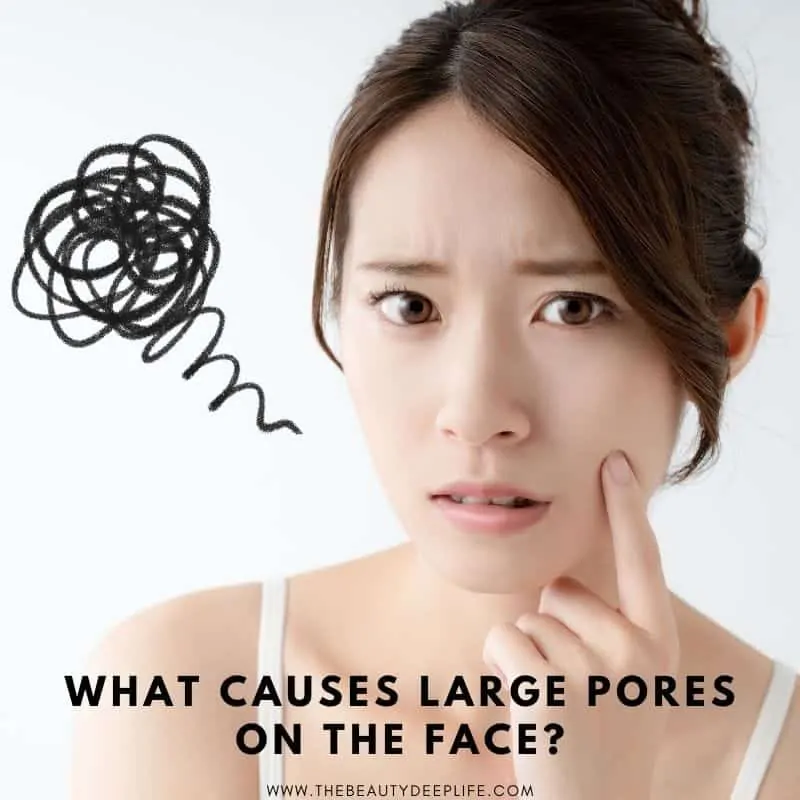
Disclosure: This post contains affiliate links, which means I receive a small commission at no extra cost to you if you make a purchase using one of these links. For more info, click to see Disclosure Policy. As an Amazon Associate, I earn from qualifying purchases.
What Causes Large Pores On The Face?
First, let’s discuss the causes, as knowing them can be crucial for pinpointing the best solutions for your skin.
There are several factors that contribute to large-looking pores; in fact, everything from genetics to sun damage, excessive oil production, environmental & topical elements, to aging skin can have an impact.
Now, while we can’t do much about genetics, we can make some changes to our skincare and makeup routines, implement some beneficial new habits, and address aging skin in ways that will help reduce those aggravating pores, ladies!
Why Do Pores Get Bigger As You Age? (Women in their mid 20’s & Up!)
Let’s address the often overlooked elephant in the room…aging skin. Those of you in your mid to late twenties and early 30’s, may not want to hear this just yet, but sadly, noticing an increase in the size of your pores is one of the early signs that your skin is starting to age.
You see, it’s not just lines and wrinkles that are signs of aging skin. As we age and our skin ages, our skin cell turnover (its natural ability to exfoliate and remove dead skin cells) begins to slow down, resulting in dullness and, yep you guessed it…. larger-looking pores.
Since your skin isn’t working quite like it used to, dead skin cells can accumulate on the surface and clog your pores, which in turn makes them appear more prominent.
Also, it’s important to note that with age, we stop producing as much collagen in our skin, and collagen begins to break down at a faster rate. Our pores are surrounded by collagen fibers, so with less collagen being produced and more breakdown, pores lose some of the collagen structurally supporting them. This is what makes your pores start to widen, flatten, and become more apparent.
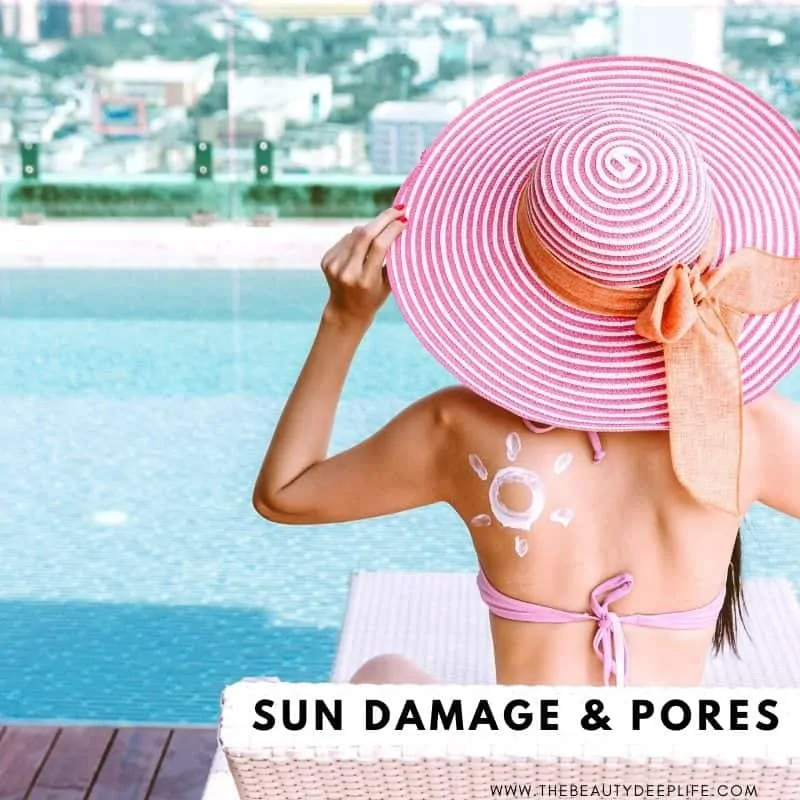
Sun Damage & Pores
If you are a sun worshipper, it may be time to nip that in the bud! UV rays contribute to larger-looking pores on our faces by thickening the skin, damaging collagen & elastin, and dehydrating your skin.
Oily Skin & Pores
Generally, those individuals with oily skin will notice larger pores because their sebaceous glands produce excessive oil. This excess oil collects in the pores making them more pronounced and visible.
In fact, you likely have noticed your pores seem more significant on your nose or your cheek areas. The reason for this is that the sebaceous glands in those particular areas produce more oil than other parts of the face. Areas that produce more oil always equate to larger-looking pores!
However, please note that individuals with combination and dry skin can also suffer from large pores.
Environmental, Topical Elements, & Pores
Not only dead skin cells and oil, but dirt, grime, sweat, and makeup from the day all can settle in your pores, causing them to stretch and expand, thus, making them appear bigger. And eventually, they can become clogged with these things, which makes matters worse.
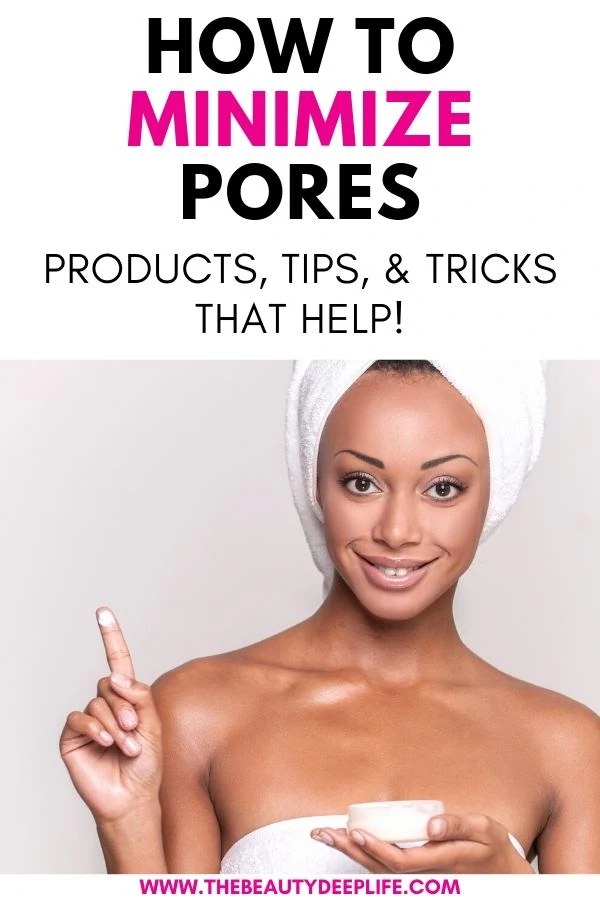
How To Minimize Pores: Products, Tips & Tricks To Help!
Now that we’ve established the primary causes, we can better understand what steps are needed to prevent and reduce the triggers. You see, when addressing enlarged pores, our primary goals need to be focused on the following:
- Controlling excessive oil production
- Preventing pores from getting clogged or stretched out with things
- Clearing & cleaning out your pores
- Reducing dead skin cell accumulation
- Preventing skin dehydration
- Reinforcing the surrounding supportive structure of the pores by slowing down collagen & elastin breakdown and increasing collagen production.
So with that said, let’s proceed with some tips, tricks, and products to help you minimize the pores on your face, shall we?
Tip 1: Look At The Labels Of Your Makeup Products
One way to keep your pores looking smaller is to keep them clear by preventing them from stretching or getting clogged. The best way to do this if you have very oily skin or combination skin is to use makeup products that are oil-free or non-comedogenic. Non-comedogenic stands for non-clogging.
Check out the labels of your products and specifically look for terms like non-comedogenic, non-acnegenic (won’t cause acne), or oil-free. If you have dry skin and large pores, you don’t have to be as strict on this.
Tip 2: Add Anti-Aging Ingredients To Your Skincare Routine
Make sure your skincare routine includes products with anti-aging ingredients. Consider using products with peptides and retinoids (serums or moisturizers).
Retinoids assist with pores in three critical ways.
- First, they speed up skin cell turnover, thus reducing the build-up of dead skin cells.
- Secondly, they assist in decreasing oil production.
- Thirdly, they help to slow down the breakdown of collagen and boost the production of collagen for your skin.

Peptides also stimulate collagen production. When your skin builds more collagen, the supportive areas around your pores plump up and making the pores appear to shrink.
You also want to add in products that contain antioxidants (Vitamin E, C, green tea, etc.). Antioxidants protect your skin from the breakdown of elastin and collagen caused by free radicals. So these ingredients work to prevent things from getting drastically worse.
I can’t stress just how important prevention is when it comes to skincare. If you want to know more about the products and the brand I find most effective for this, feel free to send me an email message.
PRO TIP: Another ingredient that can help, while not technically an anti-aging ingredient, is caffeine. Caffeine helps to minimize the pores on your face by tightening and constricting.
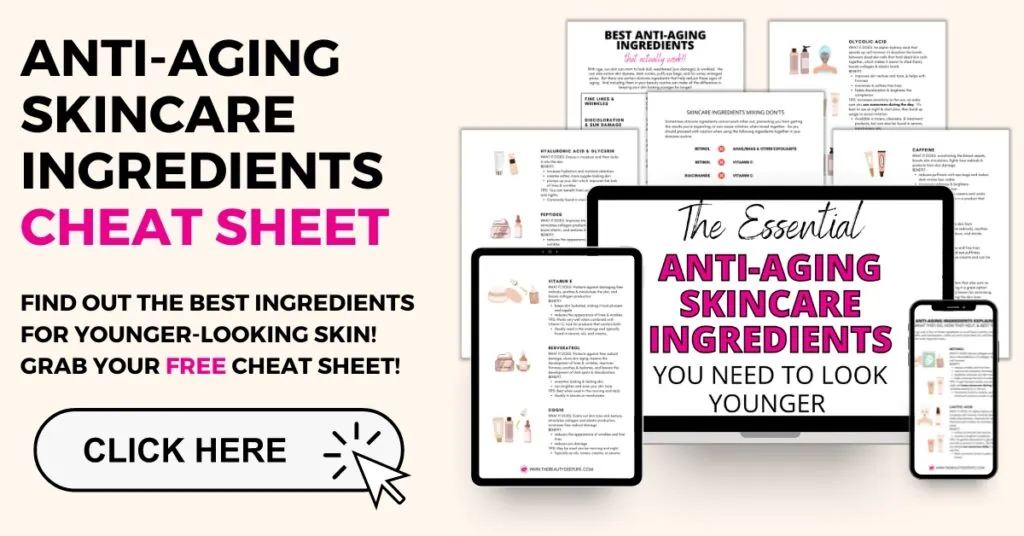
Tip 3: Cleanse Face Consistently & Daily
Clean and clear out those pores of all things that can stretch out and clog them. Consistent washing of your face twice a day is key! And of particular importance is doing so before bed, as this assists in preventing dirt, oil, sweat, and makeup from accumulating in them and clogging them.
It’s also important to prevent irritation and inflammation from occurring with your skin when washing, as this can make pores appear larger. Here’s how…
- Wash with lukewarm water not hot
- Avoid over-washing or over-scrubbing
PRO TIP: If you have dry skin, you should stick to gentle cleansers. If you have oily skin, consider trying a cleanser with sulfur, kaolin clay, or salicylic acid.
Tip 4: Add Exfoliation To Your Routine
There are two types of exfoliants, physical and chemical. Physical exfoliants include scrubs and are generally made with beads, sugar & salt, or grains. They help to minimize the appearance of pores by removing or buffing off dead skin cells that have accumulated on the surface of your face.
If you want to go this route as far as exfoliation, keep a few things in mind…
- Moderation is essential when it comes to using scrubs! Don’t over-exfoliate or scrub too harshly, as doing so can cause irritation and inflammation.
- Stick to 1-3 times a week. Start with once a week and slowly work up to 3 times a week if needed.
- Don’t use a peel if you are using a scrub. It’s best to just add one or the other to your skincare routine.
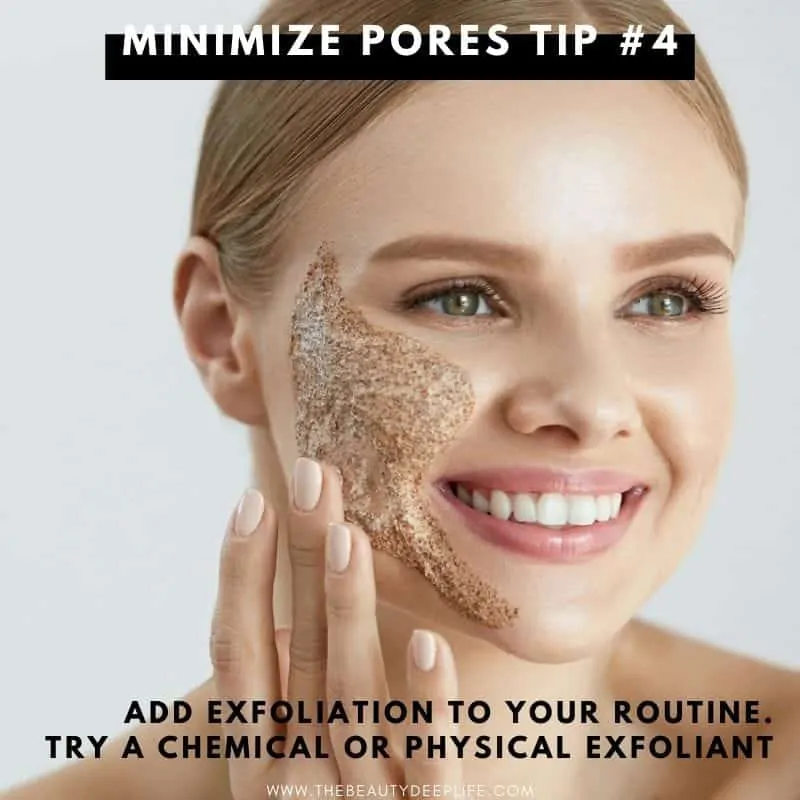
Chemical exfoliants are products that contain alpha-hydroxy acids (glycolic acid or lactic acid ), beta-hydroxy acid (salicylic acid), and/or polyhydroxy acids (the gentler option).
They assist with reducing pore size by stimulating the shedding of dead skin cells and are fabulous for cleaning the gunk out of your pores. By cleaning out your pores and eliminating pore-clogging elements, they help your pores to look smaller.
If you want to take this route for exfoliation instead, I would suggest incorporating it into your skincare routine in one of the following ways…
- Use a gentle toner or cleanser that contains polyhydroxy acids daily. Many of my clients use a gentle cleanser with very fine granules and kaolin clay that works to gently exfoliate away dead skin cells, and they follow it up with a toner that has polyhydroxy acids.
- Try using a daily low dose/concentration glycolic or lactic acid cleanser.
- Try a salicylic acid cleanser made for daily use. I use a gentle salicylic acid cleanser with sulfur. This works particularly well if you have acne-prone skin. For this, I recommend slowly working up to daily use. Generally, it’s best to start with every other day.
- OR Do a once-a-week salicylic acid (BHA) peel. *I don’t suggest you do a peel if you are using weekly scrubs or using a daily AHA or BHA cleanser.
A few things to keep in mind…
- AHA’s and BHA’s are best for normal to oily skin.
- Polyhydroxy acids are better for those prone to skin sensitivities and dryness. They don’t penetrate as deeply as AHA’s and BHA’s.
- Alpha-hydroxy acids (glycolic acid or lactic acid) can be less harsh and less irritating than physical exfoliants, aka scrubs. They increase skin cell turnover and can stimulate collagen production with use over time. Both should be used in low concentrations.
- Glycolic acid is stronger than lactic acid.
- Glycolic acid assists with absorbing excess oil and breaks down the pile-up of dead skin cells.
- Salicyclic Acid helps best with the exfoliation of dead skin cells, targeting excess oil, and unplugging clogged pores. It penetrates the skin at a deeper level than AHA’s. It’s also the perfect option if you suffer from acne breakouts in addition to enlarged pores.
PRO TIP: No matter whether you choose a chemical or physical exfoliant, be diligent in wearing sunscreen daily, as exfoliants can make your skin more sensitive to the sun.
Tip 5: Try A Weekly Face Mask
Another great way to minimize and shrink the pores on your face is by using a clay mask once a week. This will help to tighten your pores as well as reduce excess oil. This is ideal for those with oily skin.
But, if you have combination skin, simply focus on applying the mask just to the areas of concern.
PRO TIP: Look for a kaolin clay mask. For pores that clog easily or acne-prone skin, you may want to try a sulfur mask.
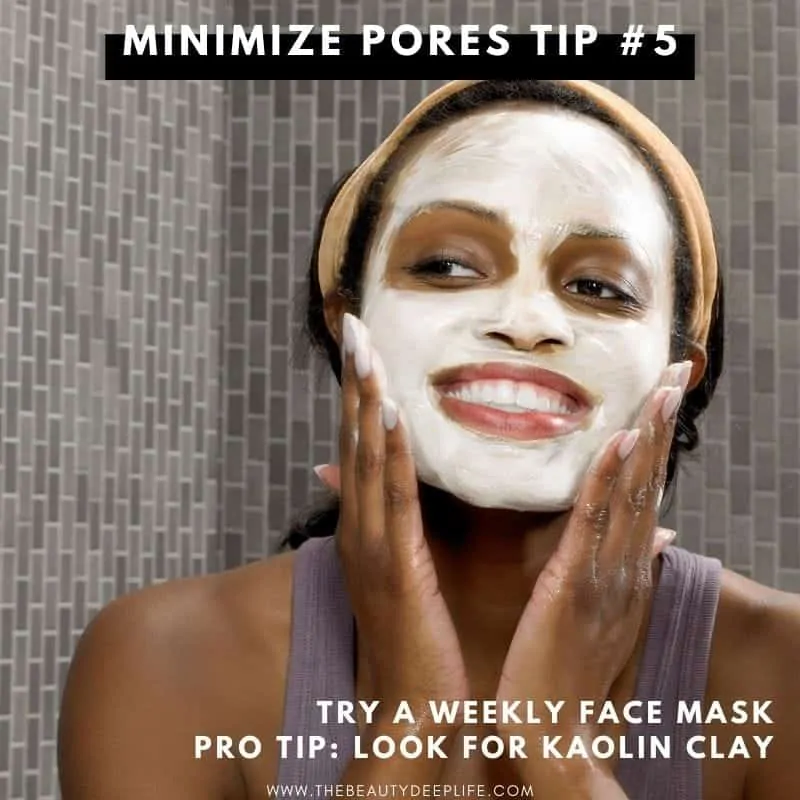
Tip 6: Make Sure Your Skin Is Hydrated
Even people with oily skin can have dehydrated skin. You see, it may appear oily on the surface, but underneath it’s dehydrated. And since it’s dehydrated, your body responds by producing excess oil to compensate for the lack of hydration.
Ultimately, you end up caught in a cycle of dehydration and too much oil production. The solution, therefore, is to hydrate your skin with humectant ingredients like hyaluronic acid and glycerin. These sorts of ingredients draw moisture from the environment and seal it into your skin.
My recommendation is to try a serum with these kinds of ingredients. Not only will it help reduce the over-the-top oil production, but it can help plump up the skin, minimizing imperfections like lines, wrinkles, and pores.
And of course, if you have dry or combination skin using moisture-attracting ingredients like hyaluronic acid and glycerin are vital, as the plumping benefits will help your pores!
Tip 7: Use SPF Daily
We’ve already established that UV rays can cause a breakdown of collagen and elastin. Collagen and elastin surround and support your pores. Loss of that support means pores get wider and flatter. Therefore, one of the best ways to prevent pores from getting any larger is to regularly protect your skin with SPF.
Tip 8: Clean Your Makeup Brushes & Tools Regularly
Since your makeup brushes and sponges come in contact with your face, it is essential to keep them sanitized. This way, you keep them from accumulating with gunk, grime, and bacteria that can clog your pores.
For individuals that suffer from enlarged pores, much like for individuals with acne-prone skin, I recommend washing your brushes more often than for other skin types.
I suggest a deep cleaning of the brushes you use most often at least once a week (the most you could safely stretch this out might be every 10-14 days or so). Brushes for concealer & foundation should be cleaned after each use with a spray cleanser.
*Keep in mind these instructions are primarily for synthetic brushes. For more tips on how to wash your makeup brushes click here!
Suffering from acne breakouts… check out these tips!!
Spray Cleaner Top Pick:
- Cinema Secrets Brush Cleaner (My #1 Favorite) – Gets all the dirt, grime, and heavy makeup out of brushes fast, doesn’t require water or rinsing, and sanitizes (kills bacteria).
Deep Cleaning Top Picks:
- Johnson’s Tear-Free Baby Shampoo – One simple way to give your brushes and sponges a gentle weekly cleaning is to use baby shampoo. This keeps them sanitized and helps to extend their life.
- Sigma Sigmatic Brush Shampoo Foam – A perfect option for deep cleaning, especially for your foundation and concealer brushes. This formula is foaming and gets the deep-down oil, makeup, and grime out of your brushes, yet gentle enough to keep them soft. You may also want to add in this cleaning mat to help get a deep-down clean with ease!
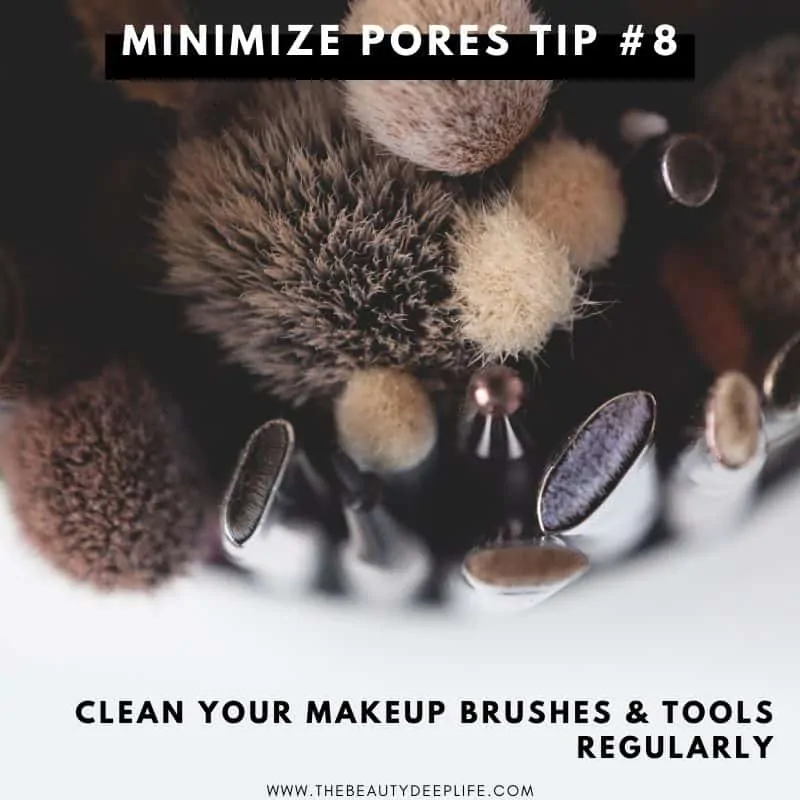
Tip 9: Use Pore Hiding & Concealing Makeup Products
Want expert tips on achieving a flawless makeup look with foundation & concealer?? Check out The Ultimate Makeup Beginners & Beyond Bundle…
Pore Minimizing Makeup Primer
Certain primers work to control oil and, most importantly, can blur your pores along with other imperfections for a flawless look & makeup finish. They are a temporary fix for your pores but still incredibly worth it! Primers also help with smoother makeup application.
So, what is the best pore minimizer? Well, if you are looking for the best options, check out our makeup round-up post on the top 5 unsurpassed primers made for hiding pores instantly!
Translucent Blurring Powders
Try a translucent powder to cut back on shine and blur those pores! Translucent powders are lightweight, which helps to prevent a cakey look. They also are less likely to settle into your pores like other powders and, thus, less likely to draw more attention to them. Check out our top picks…
This powder is actually for setting and finishing; it works for all skin tones, provides shine control, minimizes those pores, and won’t settle into fine lines and wrinkles. An added bonus, it contains antioxidants and peptides (anti-aging ingredients).
These two are not labeled as oil-free & non-comedogenic, so to stay on the safe side, I suggest them mainly for those individuals with large pores who have dry skin or combination skin rather than oily skin. For oily skin, instead, check out the next option!
This powder works on all skin tones; it doesn’t clog pores, reduces shine, and gives a matte finish! It can be used before and after applying your foundation makeup to set it. You’ll get instant pore-blurring effects using this one!
This lightweight powder is not for setting your foundation makeup but rather for finishing off your makeup look. It works best if you lightly dust it on. You don’t need much of it either. It is non-comedogenic, works on every skin tone, and helps blur out pores, fine lines, and skin imperfections.
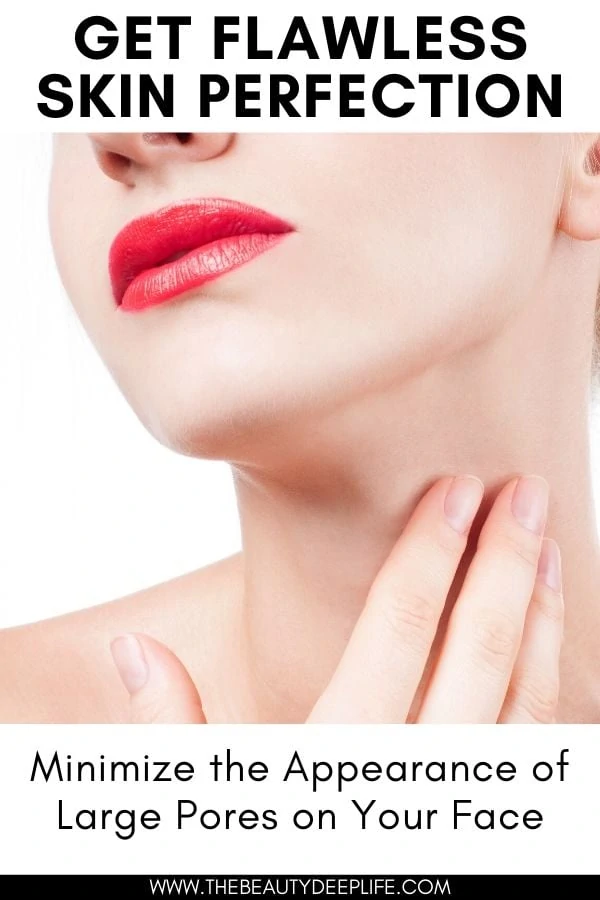
MORE MAKEUP PRO TIPS: To minimize the look of large pores on your face when wearing makeup, first, don’t apply your foundation using your fingers; opt for a sponge or brush.
Secondly, avoid shimmers in blush, highlighters, and powders, as the shimmer in such products will draw more attention to your pores.
Tip 10: Add In Products To Help Slowly
I know you may be eager to get those pores in check, but it’s important not to go overboard. Oftentimes, out of a desperate need to find a solution, people buy everything they can find to help.
They start using all their new products all at once, and then they find nothing improves, or even worse, the problem gets even bigger.
Start with one new skincare product, your mask, cleanser, scrub, peel, etc., a week. See how your skin acclimates to it before adding in other items.
Mixing too many products at the same time can cause irritation and dryness, which can trigger extra oil production and ultimately make the pores look larger again. So, add things in slowly and ramp up as needed. Slow and steady wins the race!
Tip 11: Avoid The Heavy In Skincare Products!!
Heavy oils and super-rich moisturizers should be avoided to prevent excess oil from accumulating in the pores. As we established, excess oil stretches out your pores.
Sheerer water-based products tend to work better if you are looking to minimize and improve the look of pores on your face.
PRO TIP: It is often said that having Zinc and Magnesium in your skincare products can help with controlling excess oil production.
What’s Good For Large Pores On The Face…The Wrap-Up!!
When it comes to the face and ways to minimize your pores, it really only takes a few products and habit switch-ups to see major improvement.
Now that you know what to avoid and what ingredients to look for, start paying attention to the labels. Most importantly, get on a consistent routine, following the skincare and makeup habits and tips suggested in this article. And lastly, slowly ramp up if your skin needs more as far as skincare, so as not to overdo it.
Do you prefer physical or chemical exfoliation? I would love to hear your preference! Leave a comment below… 🙂
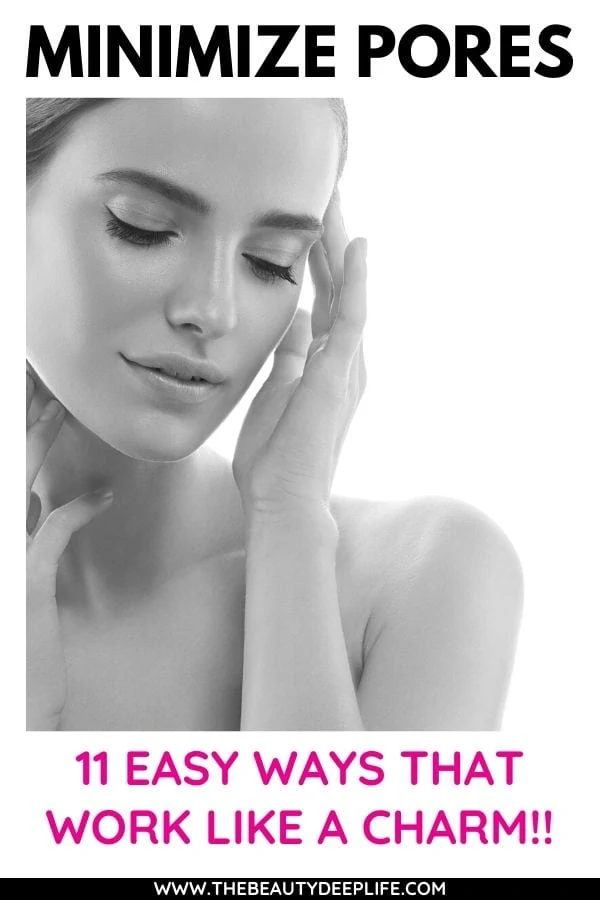
Related Articles:
- The Best Guide to Women’s Essential Skincare Tips
- How To Care For Dry Winter Skin: Finally End Your Winter Skincare Woes
- How To Have Healthy Glowing Skin: 7 Expert Tips
- 27 Winning Ways To Stop Acne!!
- Beginner Makeup for the Everyday Woman
We are a participant in the Amazon Services LLC Associates Program, an affiliate advertising program designed to provide a means for us to earn fees by linking to Amazon.com and affiliated sites. For more info, see Disclosure Policy.
